This Blood Test Predicts Death, Even When Everything Else Looks “Great” (Re-blog: Functional Medicine University)

This Blood Test Predicts Death, Even When Everything Else Looks “Great”
Ronald Grisanti D.C., D.A.B.C.O., D.A.C.B.N., M.S.
As I discussed in a recent article, I mentioned the prognostic power of the blood test brain natriuretic peptide (BNP).
Remember there is a 25% increase in death if the BNP is elevated one year after a heart attack. And don’t forget a BNP persistently over 80 pg/mL can be an important indicator of when a more invasive approach is needed such as bypass surgery.
In fact, a BNP twice the normal range can indicate a quadruple risk of death in folks who don’t even have symptoms. There is no other test that has the ability to have this crystal ball power of determining your chances of succumbing to heart failure even if you have no symptoms.
As a brief explanation, BNP is a neuro-hormone made in and released from the heart ventricle. The ventricles of the heart make up the biggest part of the heart muscle that squeezes blood through all the rest of the body. When the ventricles are under too much tension or the work load on the ventricles is too much the BNP goes up.
Basically, if the heart is working overtime to function, the BNP is made in larger quantities to help rescue the heart. The key thing to remember is the BNP will commonly increase long before you have any signs or symptoms that you have any trouble. This is one reason to make sure you keep your blood pressure well within normal levels because it reduces stress on the ventricles
What I find so disturbing is the fact that this is not a new test. It has been around for decades. Can you believe that most cardiologists are not aware of it and if they are, they still don’t order it? 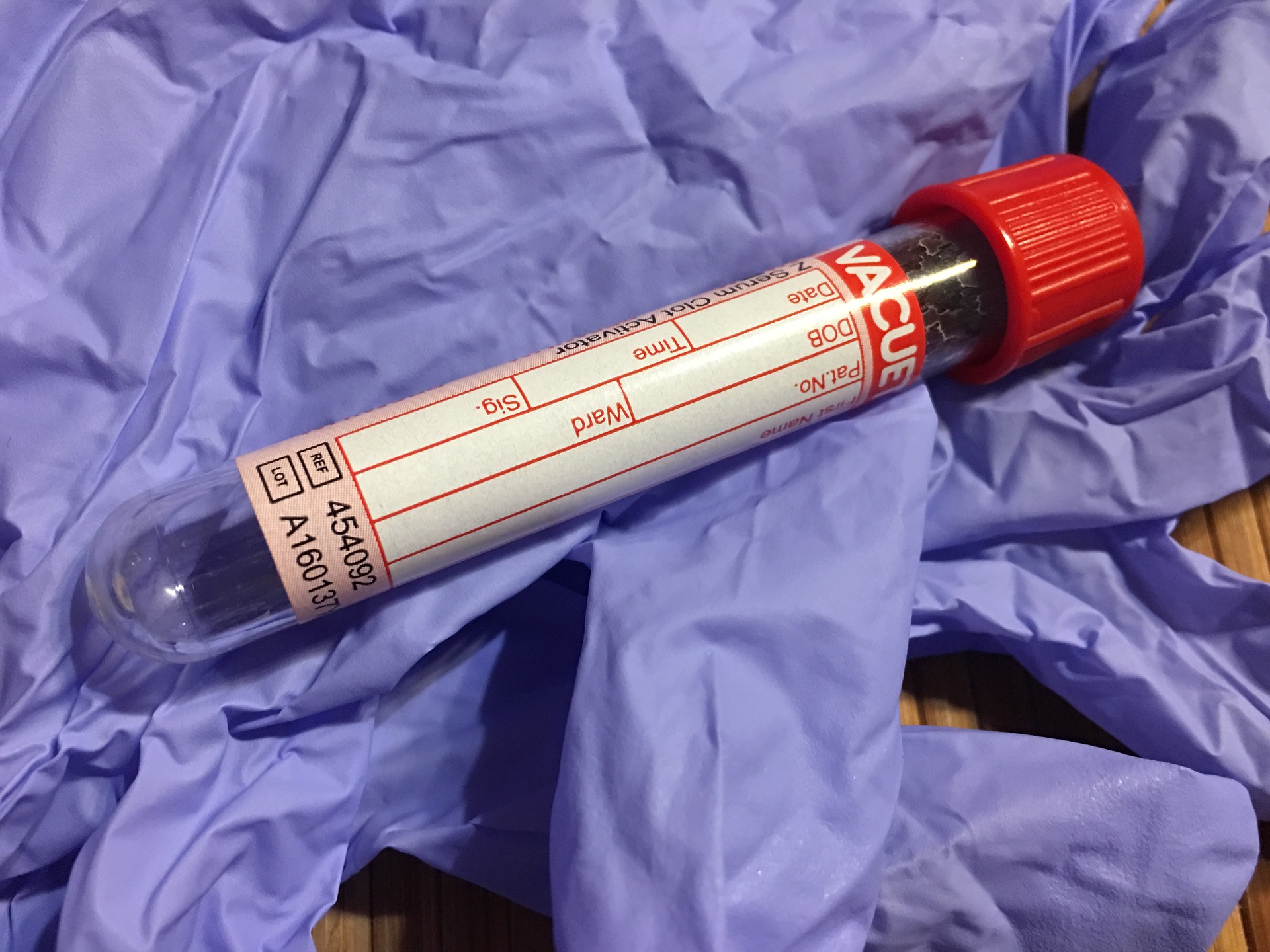
On the other hand knowledgeable “research” cardiologists over ten years ago published in the Journal of the American Medical Association stated the BNP test “was a stronger biomarker for cardiovascular disease and death than the C-Reactive Protein”.
One of the reasons you have not heard more about this test is because there is no drug the pharmaceutical has to treat the elevated BNP.
It is important to understand that a normal BNP according to the traditional medical think should not indicate that you are ok. Studies show that you have a ten-fold risk of early death if you’re in the fourth quintile or in other words in the top ¼ of the normal range, but still in “normal”. Others have shown a 50% increase in death in the fourth quintile while others have shown 20% increase in death above the fourth quintile.
The main point I want to make is to insist your doctor orders the BNP/pro-BNP test to determine if you are heading toward heart failure.
Clearly the BNP has provided information about the risk of dying than no other test can, yet it has been persistently ignored. The leading cardiology journal says, “Serial determinations of BNP levels during outpatient follow-up after acute coronary syndrome predicts the risk of death or new congestive heart failure.
How to treat an elevated BNP
I will now show you natural nutrients that down-regulate the BNP.
The solution is taking real vitamin E which includes four tocopherols and four tocotrienols (alpha, beta, gamma, and delta).
It turns out that the tocotrienols is a precursor to natriuretic hormone and is an essential part of what the body uses to make BNP to help heal the heart. The sad thing is if you ask your cardiologist or other doctor about tocotrienols, most have never even heard of them, even though they are crucial for treating an abnormal BNP. And of course this is not new, as it has been known for over a decade that gamma tocotrienols can lower BNP.
Don’t forget tocotrienols are necessary for fighting cancers making cancer cells commit suicide and stopping metastases. In fact, tocotrienols have been shown to stop the growth of human breast cancer cells, improve blood pressure, prevent abnormal clotting, improve diabetes and much more. Name one medication that does all of that! Instead we have cardiologists and oncologists who have never heard of tocotrienols and do not prescribe this absolutely necessary nutrient to people who need it the most.
One of the other parts of vitamin E, gamma tocopherol also lowers the BNP. And this one as well as the gamma tocotrienol are usually low in patients with coronary heart disease. Be careful that you stay away from plain generic “vitamin E” (which is usually synthetic alpha-tocopherol) which actually lowers the gamma tocotrienols. Always check your multi vitamin and see if it only contains alpha-tocopherol, one of 8 parts of vitamin that you see advertised on TV because they will drive down the other forms of E that are not in it. Get rid of it.
So again what do you do for your elevated BNP ?
First thing is to make sure you have good levels of the eight forms of vitamin E.
{You are probably wondering WHERE do I get a balanced supplement? Well – here is a link that has a great spreadsheet with details of the different supplements Toxinless.com}
that has a great spreadsheet with details of the different supplements Toxinless.com}
BNP also responds to low salt. Change your salt to a potassium salt substitute, available in all grocery store.
The bottom line? The BNP blood test shows risk even when all other tests are normal and even when the person has no symptoms. So after you have ordered your BNP and Pro-BNP, then do not hesitate to take the complete vitamin E and also request your doctor orders a Cardio/ION. Might as well get the best test to get an accurate status on your other heart markers and know what to do to treat any of the abnormal findings.
References
• Weidemann A, et al, Hypoxia, via stabilization of the hypoxiainducible factor HIF-1a, is a direct and sufficient stimulus for brain-type natriuretic peptide induction, Biochem J, 409:233-42, 2008 (predicts before symptoms, also useful for cancer hypoxia as well as heart)
- Rogers Sherry, Total Wellness, Prestige Publishing, May 2013
• Lorgis L, et al, High levels of N-terminal pro B-type natriuretic peptide are associated with ST resolution failure after reperfusion for acute myocardial infarction, Q J Med, 100:211-16, 2007 (better predictor than ejection fraction, level over 900 means EKG ST damage not resolved, hypoxia leads to CHF)
• James SK, et al, N-terminal pro-brain natriuretic peptide and other risk markers for the separate prediction of mortality and subsequent myocardial infarction in patients with unstable coronary artery disease: a Global Utilization of Strategies To Open Occluded Arteries (GUSTO)-IV substudy, Circulation 108:275-81, 2003
• Tapanainen JM, et al, Natriuretic peptides as predictors of non-sudden and sudden cardiac death after acute myocardial infarction in the beta-blocking era, J Am Coll Cardiol 43; 5:757-63, 2004
Omland T, et al, B-type natriuretic peptide and long-term survival in patients with stable coronary artery disease, Am J Cardiol, 95:24-8, 2005
• Morita E, et al, Increased plasma levels of brain natriuretic peptide in patients with acute myocardial infarction, Circulation, 88:82-91, 1993
• Morrow DA, NACB Writing Group, National Academy of Clinical Biochemistry laboratory medicine practice guidelines: clinical characteristics and utilization of biochemical markers in acute coronary syndromes, Circulation 115: e356-75, 2007
• Omland T, et al, N-terminal pro-B-type type natriuretic peptide and longterm mortality in acute coronary syndromes, Circulation 106:2913-8, 2002
• Morrow DA, Prognostic value of serial B-type natriuretic peptide testing during follow-up of patients with unstable coronary artery disease, J Am Med Assoc 294:2866-71, 2005
• Richards M, et al, Comparison of B-type natriuretic peptides for assessment of cardiac function and prognosis in stable ischemic heart disease, J Am Coll Cardiol, 47:52-60, 2006
• Richards AM, et al, B-type natriuretic peptides and ejection fraction for prognosis after myocardial infarction, Circulation 107:2786-92, 2003
• Kragelund C, et al, N-terminal pro–B-type natriuretic peptide and long-term mortality in stable coronary heart disease, New Engl J Med 352:666-75, 2005
• Kistorp C, et al, N-terminal pro-brain natriuretic peptide, C-reactive protein, and urinary albumin levels as predictors of mortality and cardiovascular events in older adults, J Am Med Assoc, 293:1609-16, 2005
• Harma N, et al, Rapid ventricular induction of brain natriuretic peptide gene expression and experimental acute myocardial infarction, Circulation 92:1558- 64, 1995
• Saito H, et al, Gamma-tocotrienol, a vitamin E homolog, is a natriuretic hormone precursor, J Lipid Res, 44;8:1530-5, 2003 (a decade ago!)
• Hattori A, et al, Production of LLU-a following an oral administration of gamma-tocotrienols to rats, Biol Pharm Bull 23; 11:1395-7, 2000
• Parker RA, et al, Tocotrienols regulate cholesterol production in mammalian cells by post-transcriptional suppression of 3-hydroxy3- methyl glutaryl coenzyme A reductase, J Biolog Chem 268; 15:11230-8, 1993 (2 decades ago!)
• Inokuchi H, et al, Anti-angiogenic activity of tocotrienols, Biosci Biotechnol Biochem 67:7:1623-27, 2003
• Wan Nazaimoon WM, et al, Tocotrienols-rich diet decreases advanced glycosylation end products in non-diabetic rats and improves glycemic control in streptozotocin-induced diabetic rats, Malaysian J Pathol 24; 2:77-82, 2002
• Sylvester PW, et al, Role of GTP-binding proteins in reversing the anti-proliferative effects of tocotrienols in preneoplastic mammary epithelial cells, Asia Pacific J Clin Nutr 11 (suppl 7): S452-9, 2002
• Steiner M., Vitamin E: more than an antioxidant, Clin Cardiol 16 (4 suppl 1): 116-8, 1993
• Newaz MA, et al, Effect of gamma tocotrienols on blood pressure, lipid peroxidation and total antioxidant status in spontaneously hypertensive rats (SHR), Clin Exper Hypert (New York) 21; 8:1297-1313, 1999
• Nakagawa K, et al, DNA chip analysis of comprehensive food function: inhibition of angiogenesis and telomerase activity with unsaturated vitamin E, tocotrienol, BioFactors 21; 1-4:5-10, 2004
• Ohrvall M, et al, Gamma, but not alpha, tocopherol levels in serum are reduced in coronary heart disease patients J Intern Med, 239:111-7, 1996
• Uto-Kondo H, et al., Gamma tocopherol accelerated sodium excretion in a dose dependent manner in rats with a high sodium intake, J Clin Biochem Nutr 41: 211-17, Nov 2007
• Uto H, et al, Gamma-tocopherol enhances sodium excretion as a natriuretic hormone precursor, J Nutr Sci Vitaminology 50:277-82, 2004
• Kantoci D, et al, Endogenous natriuretic factors 6: the stereochemistry of a natriuretic gamma tocopherol metabolite LLU-a, J Pharmacol Exper Therap 282:648-56, 1997
• Murray EED, et al, Endogenous natriuretic factors 7: Biospecificity of a natriuretic gamma tocopherol metabolite LLU-a, J Pharmacol Exper Therap 282 657-62, 1997
Before prescribing treatment, FMU recommends that you follow the standard of care of your profession, as well as confirm the information contained herein with other sources.
Functional medicine embraces the totality of the regulatory functions of the body. It encompasses all of the biophysical, biochemical, enzymatic, endocrine, immunological, and bioenergetic regulatory capacities.
Ronald Grisanti D.C., D.A.B.C.O., D.A.C.B.N., M.S.
Compliments from Functional Medicine University
http://www.functionalmedicineuniversity.com/public/department88.cfm
Spectacular Kohlrabi & Beef Vegetable Medley Quiche
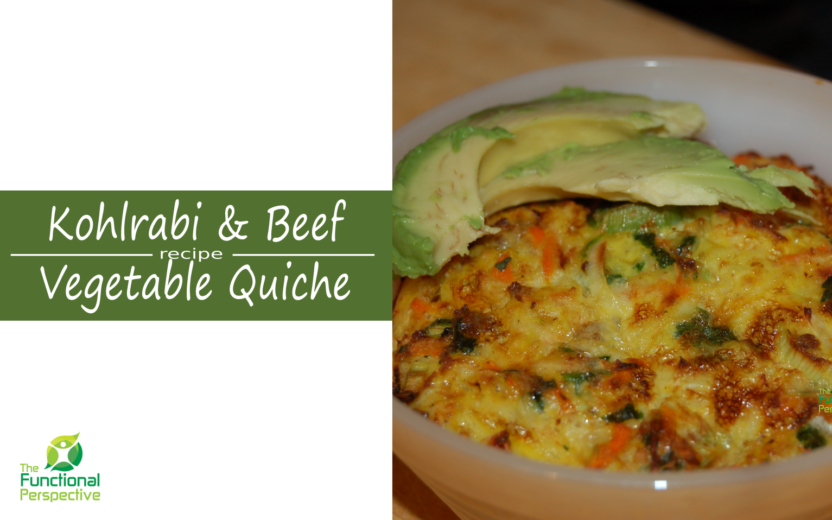
The weather has turned brisk which calls for warm delicious snacks. We had some kohlrabi that I needed to do something with so a quick search on pinterest and thus the inspiration for our afternoon snack!

Inspired by: Flavor and Savour
[/recipe-notes] [recipe-ingredients] – 2 Small Kohlrabi – grated
– 1 cup grated Carrot
– 1 small Leek
– 1 cup Baby Spinach leaves(before chopping)
– 13 Eggs
– 1/2 lb ground Beef (I used grass-fed)
– 1 1/2 tsp Salt (I most often use “Real Salt”)
– optional garnish: Avocado slices
[/recipe-ingredients] [recipe-directions] 1. Pre-heat oven to 375
2. Rinse and grate Kohlrabi, add 1 tsp of salt – mix well and sit aside while preparing the rest of the ingredients.
3. Brown the Ground Beef on medium low with 1/2 tsp Salt while preparing the rest. Remember to check for being fully cooked while preparing the other ingredients.
4. Crack eggs and mix well in large mixing bowl
5. Peel and grate Carrots – add to eggs.
6. Rinse and chop Leek – add to egg mixture.
7. Chop the Baby Spinach and add to the egg mixture.
8. Finish cooking the ground meat, if it is not done yet and then set aside in a small bowl to cool off a little before adding to the eggs.
9. With a cheese cloth or by another method – squeeze out as much water from the Kohlrabi as you can before adding it to the mixture. Then add to egg mixture
10. Add the Beef to the egg mixture.
11. Mix all of the ingredients together well. Be sure to stir from the bottom as the eggs will sink to the bottom of the mixture.
12. Spoon mixture into 3 individual large ramekins.(again making sure to get at least one spoonful from the bottom of the bowl. Place remainder into a quiche or small pie pan. Place ramekins on a baking sheet, optional for pie plate, and place in oven for about 45 minutes.
13.TIPS: Keep some ground beef cooked in your freezer in 1/2 to 1 lb packages, when you are in the need for a quick meal you can pull them out and make a casserole or simple quiche. When preparing leeks make one slice long ways and that will allow you to rinse any dirt that may get down in the lower layers, this also makes it easier to chop them by laying them on the flat side.
[/recipe-directions] [/recipe]
Expert Talk: David Perlmutter, MD Brain Inflammation, Autoimmune Disease and Nutrition

I just listened to the first ‘bonus’ video from the Autoimmune Revolution and I was STUNNED! ABSOLUTELY FABULOUS!!! I am looking forward to the rest of the videos – I have a feeling it is going to end up being a great resource for me on this journey… If you missed my previous post here is another link below to sign up for the free content!
After registering you will get an email confirmation with a link to the bonus content – The video I just watched was:
Expert Talk: David Perlmutter, MD Brain Inflammation, Autoimmune Disease and Nutrition
(Here is Dr. Perlmutters website http://www.drperlmutter.com/
https://www.thunderclap.it/projects/50763-the-autoimmune-revolution/embed
So, which came first?

Which came first – autoimmune disease or malfunction in the body?
(Update 4/11/2017: Check out this post for a hint)
Beta cell regeneration – Hope for T1 Diabetics

I was at a wedding this evening and as our creator would have it my path crossed with another functional medicine minded individual with a Type 1 Diabetic family member! One of the tidbits I picked up from this blessed encounter was the role the spleen plays in beta cell regeneration.. So you all can probably guess one of the first things that I did upon returning home was head to the research portals to see what I could dig up.. Well this was the first one I came across (while I was munching on leftover chili)
Here is the abstract:
Approaches Towards Endogenous Pancreatic Regeneration
https://www.ncbi.nlm.nih.gov/pmc/articles/PMC1783561/
Banerjee M, Kanitkar M, Bhonde RR. Approaches Towards Endogenous Pancreatic Regeneration. The Review of Diabetic Studies. 2005;2(3):165-176. doi:10.1900/RDS.2005.2.165.
The phenomenon of pancreatic regeneration in mammals has been well documented. It has been shown that pancreatic tissue is able to regenerate in several species of mammal after surgical insult. This tissue is also known to have the potential to maintain or increase its β-cell mass in response to metabolic demands during pregnancy and obesity. Since deficiency in β-cell mass is the hallmark of most forms of diabetes, it is worthwhile understanding pancreatic regeneration in the context of this disease. With this view in mind, this article aims to discuss the potential use in clinical strategies of knowledge that we obtained from studies carried out in animal models of diabetes. Approaches to achieve this goal involve the use of biomolecules, adult stem cells and gene therapy. Various molecules, such as glucagon-like peptide-1, β-cellulin, nicotinamide, gastrin, epidermal growth factor-1 and thyroid hormone, play major roles in the initiation of endogenous islet regeneration in diabetes. The most accepted hypothesis is that these molecules stimulate islet precursor cells to undergo neogenesis or to induce replication of existing β-cells, emphasizing the importance of pancreas-resident stem/progenitor cells in islet regeneration. Moreover, the potential of adult stem cell population from bone marrow, umbilical cord blood, liver, spleen, or amniotic membrane, is also discussed with regard to their potential to induce pancreatic regeneration.
Did you catch that? Look at several factors which play a role in the regeneration…
“Various molecules, such as glucagon-like peptide-1, β-cellulin, nicotinamide, gastrin, epidermal growth factor-1 and thyroid hormone, play major roles in the initiation of endogenous islet regeneration in diabetes.”
Looks like I have the next few days cut out looking more in-depth as to what gets those things out of balance, what is needed to return those molecules to a homeostasis, what tests available to determine the status of those molecules in our system… my list will grow!
Anyway – just had to share as it’s another confirmation of hope for T1’s – when our perspective is changed from symptom management to system restoration our health takes on a whole new meaning! Hope you all are excited about our upcoming new year – I know I am! That’s it for now…
Ch-ch-chili, celeriac style
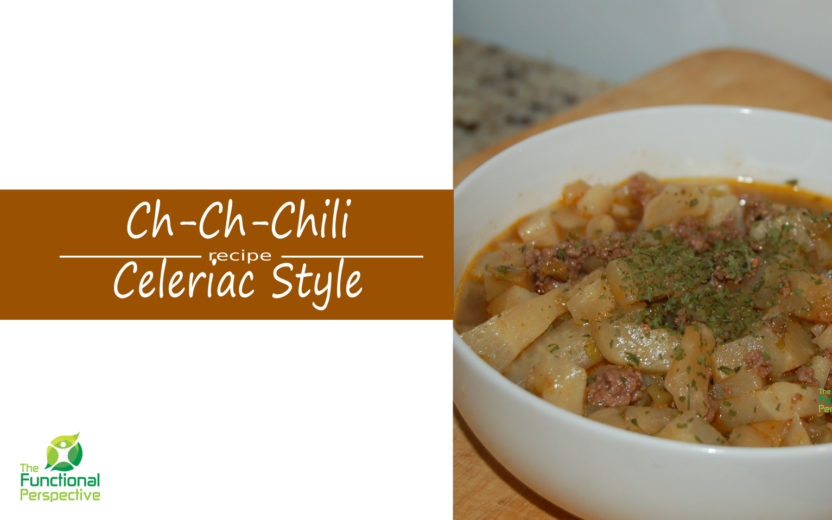 [et_pb_section bb_built=”1″][et_pb_row][et_pb_column type=”4_4″][et_pb_text]
[et_pb_section bb_built=”1″][et_pb_row][et_pb_column type=”4_4″][et_pb_text]
Cold weather necessitates making some hearty, warming chili!!! We have been loving the celeraic so much I thought I would attempt a different twist – well according to the kiddos it turned out to be SENSATIONAL!!! (I have to agree with them 🙂

[recipe title=”Ch-ch-chili, Celeraic Style” servings=”3-4″ time=”1 1/2 – 2 hrs” difficulty=”easy” image=”” description=”Hearty, satisfying heart warming chili!”]
[/recipe-notes] [recipe-ingredients] – 1 lb ground meat(I used grass-fed beef)
– 1 medium Celeriac (chopped/cubed)
– 3 stalks of Celery
– 1 large can of Chilis
– 1/2 c. chopped Onion
– 1 tsp. Paprika
– 3 cloves Garlic, mashed and diced
– 1 tsp. Salt
– 1 tsp. Chili Powder
– 1 tsp. Cayenne Powder
– 1 TB Butter or olive oil
– 4 C. Water
– 1 C. Beef Broth [/recipe-ingredients] [recipe-directions] 1. Peel and chop Celeriac – saute in butter(or oil) in large pot while preparing the rest of veggies.
2. Rinse and chop Celery, dice up onion – add to the Celeriac, saute for about 3-4 more minutes
3. Peel and mash, dice Garlic. Empty veggie contents into a bowl and set aside while preparing the meat. Add Garlic, spices and salt with Meat to the pot and cook until the meat is done.
4. Add veggies back to the pot with the meat. Stir well then add water and broth – cook for approx 90 minutes. Then ENJOY!
5. TIPS: This can be made with a variety of ground meat. [/recipe-directions] [/recipe] [/et_pb_text][/et_pb_column][/et_pb_row][/et_pb_section]
Super easy grain-free banana pancakes
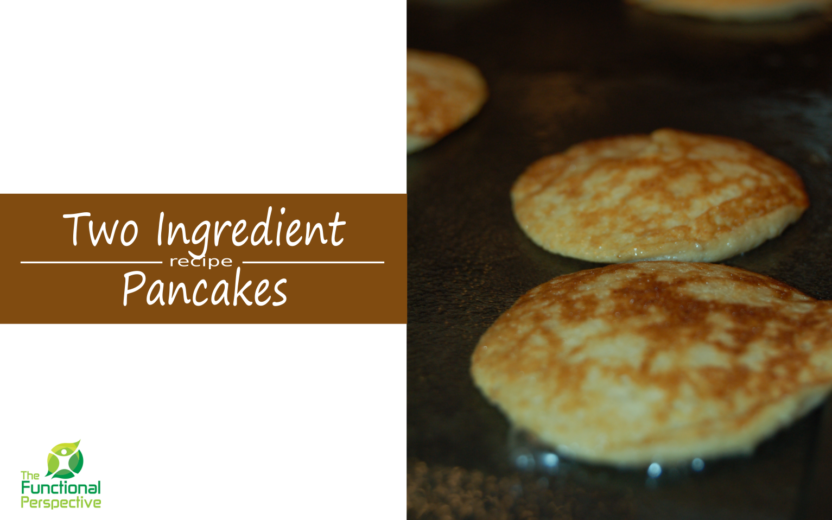 [et_pb_section bb_built=”1″][et_pb_row][et_pb_column type=”4_4″][et_pb_text]
[et_pb_section bb_built=”1″][et_pb_row][et_pb_column type=”4_4″][et_pb_text]
There is nothing like a warm breakfast that is filled with scrumptious flavors!!!
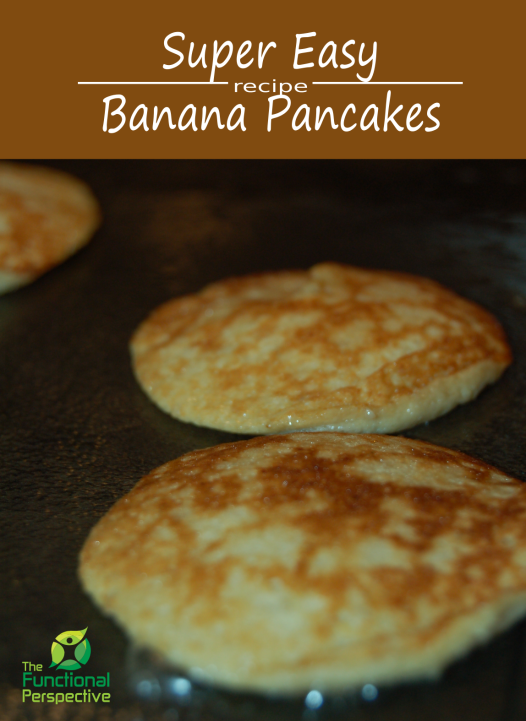
[/recipe-notes] [recipe-ingredients] – 1 Egg
– 2 Bananas
– pinch of Salt (optional)
– Butter or Oil to grease pan
[/recipe-ingredients] [recipe-directions] 1. Peel and mash Bananas
2. add Egg & stir well
3. Grease hot griddle or skillet and Pour small amount onto hot griddle (medium heat, not too hot) or into a hot skillet
4. Cook approximately 3-4 minutes on each side (varies depending on skillet temperature)
5. Serve warm!
6. TIPS: You don’t want the heat too high or they get done on the outside too fast. They seem to cook better on medium to medium-low heat. I sprinkle just a touch of salt on pancakes after finished cooking. Also- they can be difficult to flip, highly recommend a very thin metal spatula for flipping. And when you grease your skillet or griddle use a cold oil, such as butter straight out of the refrigerator or cold coconut oil from refrigerator. [/recipe-directions] [/recipe] [/et_pb_text][/et_pb_column][/et_pb_row][/et_pb_section]
Celeriac Surprise Soup
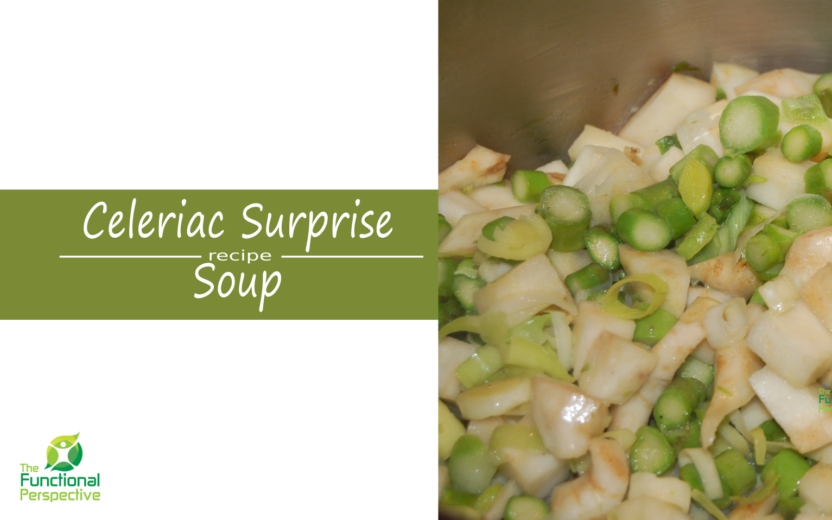
We really enjoyed the Celeriac Creamy (or Not) soup that I made last week and decided to try our hand at another celeriac combination! So, I looked in our refrigerator to see what I could throw together and thus I present:

[recipe title=”Celeriac Surprise Soup” servings=”4-6″ time=”2hr 30mins” difficulty=”easy” image=” description=”Tasty combination of celeriac, leeks, asparagus and mushrooms.”]
[recipe-notes]
Credit: The Functional Perspective
[/recipe-notes]
[recipe-ingredients]
– 1 Celeriac Root
– 10-12 stalks of Asparagus
– 1 small Leek
– 5 ounces Shiitake Mushrooms
– 1 tsp salt (I use Himalayan or Real Salt)
– 1 TB Coconut Oil or Grass-fed Butter
– 1 TB of Olive Oil
– 6 cups Water
– Optional: 1-2 cups homemade beef or chicken broth (I used some beef broth, a little over a cup)
– Optional garnishes: Spoonful of Chilled Coconut Milk, Roasted Pumpkin Seeds, Parsley or other Herbs
[/recipe-ingredients]
[recipe-directions]
1. Rinse, peel and chop Celeriac
2. Melt oils, on medium heat, in large stock pot and add Celeriac
3. While Celeriac is sauteing rinse and chop Leek, Asparagus and mushrooms. Occasionally stirring Celeriac.
4. Add Leeks, Asparagus and Mushrooms. Saute and stir about 3-4 minutes.
5. Add water and bring to a boil. Then cover and turn down to a low boil/simmer for about 2 hours
6. After almost two hours add optional broth and simmer another 10 minutes
7. Garnish with spoonful of coconut milk, parsley, pumpkin seeds or other favorite garnishes!
8. TIPS – I will often add a cup or two of beef or chicken broth during the remaining 10 min – especially the broth that is saved from a roast.
[/recipe-directions]
[/recipe]
